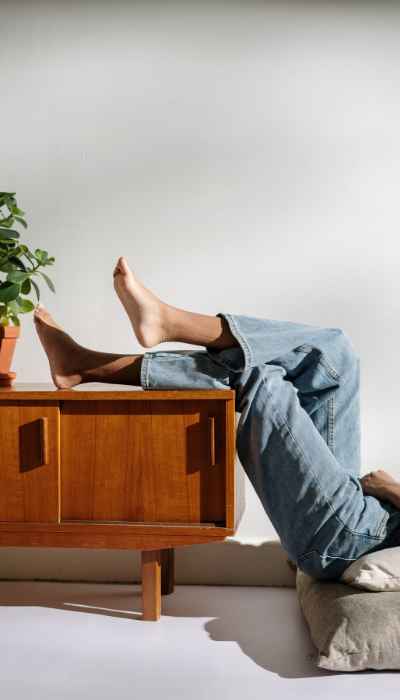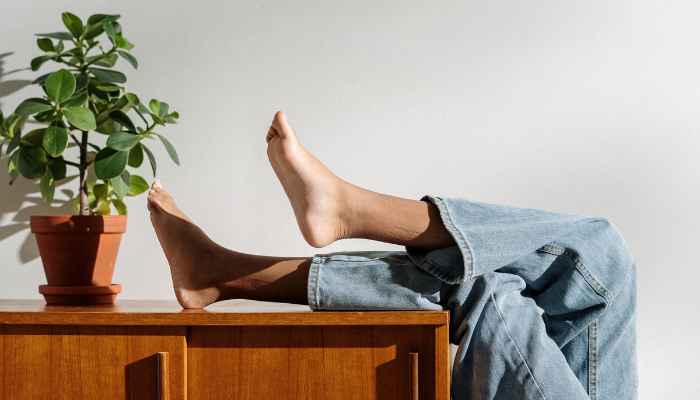Last Updated on February 16, 2025


Calluses are thick and tough layers of skin that develop when the skin protects itself from friction and pressure. They can form on the hands and fingers but are most often found on the feet. Calluses commonly form on the pressure points like the heels and balls of your feet. These dry, rough spots of skin can vary in size and shape and are less sensitive than the surrounding skin, but we want callus-free feet.
Typically, calluses aren’t painful. However, some people may experience discomfort when they put pressure on their feet while walking and wearing shoes. Additionally, the thick and hardened appearance of calluses can look unpleasant.
If you feel uncomfortable or are particular about the appearance of your feet, there are a few things you can do to remove and prevent calluses from developing on your feet. Here are some simple care tips to help achieve soft and callus-free feet.
Callus-Free Feet: Wear Socks
The main cause of calluses is friction and pressure from repeated actions, including walking around and standing for long periods. A simple way you can protect your feet from developing calluses is to wear soft comfortable socks. They create a barrier between your feet and shoes so your feet won’t rub against the shoe material. Socks can also prevent your feet from becoming stinky.
Wearing socks helps to keep your feet cool and dry, so odor-causing bacteria won’t have a warm and moist place to thrive in. If you wear shoes for long hours during the day, it’s a good idea to buy antimicrobial socks. This material is specially formulated to resist bacterial growth and is more effective in reducing unwanted foot odors.
When shopping for the right pair of socks, make sure they’re thick and soft enough to protect your feet from any friction. Also, remember not to get socks that are too loose or tight as they can also lead to developing calluses. Loose socks may repeatedly slip from your feet and leave them exposed, while tight socks can feel uncomfortable and add pressure to your feet.
Callus-Free Feet: Get Shoes that Fit Just Right
Wearing ill-fitting shoes is also another cause of pressure and friction on your feet, which can lead to developing calluses. To ensure your feet stay callous-free, remember to get footwear that doesn’t feel too loose or too tight on your feet. Wearing tight shoes will constrict your feet and increase the likelihood of them rubbing against the shoe interiors. If the shoe is too big for you, however, your foot will move around too much and generate a lot of friction.
As a recommendation, buy shoes at the end of the day when your feet have swelled and are at their largest. This way, you can make sure you get footwear that feels comfortable throughout the day. It’s also helpful to get ample-width shoes so the ball of your foot comfortably fits in the widest part of the footwear.
Additionally, inspect the space at the end of the shoes. Stand up and see if you can slip a finger between the end of the shoe and your heel to check. There should be three-quarters or half an inch of space so the fit isn’t too tight. Lastly, walk around the store before buying a pair of shoes so you can get a feel for them. This allows you to find out if the shoes fit comfortably or if you feel any chaffing anywhere.
Callus-Free Feet: Avoid Wearing Sandals All the Time
Another common reason your feet develop calluses is wearing sandals all the time. While open-toed shoes and flip-flops allow your feet to breathe, the open design can cause your feet to slide around and develop calluses from friction. Also, sandals expose your feet to the elements, which contributes to the development of dry and rough-looking skin.
If you want to have soft and smooth feet, limit wearing sandals and flip-flops to a few events. In case you’ll be walking all day, it’s best to wear closed shoes with socks to keep your feet protected from various elements.
Callus-Free Feet: Exfoliate and Moisturize Your Feet
To keep your feet feeling smooth, regularly exfoliate your feet. While in the shower, use a gentle abrasive scrubber, loofah, or pumice stone to scrub away the dead skin on your feet. This can also reduce the size of calluses as they often form from dead layers of skin.
Additionally, remember to regularly moisturize your feet. Use a moisturizing lotion, cream, or oil and apply them to your feet after bathing. This keeps your skin hydrated and reduces the formation of calluses. The extra moisture also helps loosen up small skin cells so the dry skin can be naturally shed from your foot instead of developing into calluses.
Calluses are normal and many people often have them on their feet. Fortunately, you can take measures to reduce their appearance and prevent more calluses from developing on your feet. Identifying and removing the sources of friction and pressure on your feet can also contribute to your comfort and foot health. However, if a callus becomes inflamed or too painful, contact a podiatrist for proper treatment.
What removes calluses from feet?
Corns and calluses can be softened by soaking them in warm, soapy water. The thicker skin may be simpler to remove as a result. thickened thin skin. Rub the corn or callus with a pumice stone, nail file, emery board, or washcloth after you’ve softened the affected skin.
How do I keep my feet callus free?
While you’re in the bathtub or shower, massage your callus with a pumice stone. To relieve pressure, use corn pads.
What can I do to avoid corns and calluses?
Put on shoes that are comfortable for your feet.
Stay away from daily high-heel wear.
To further lessen rubbing and pressure on your foot, use gel pad inserts.
Is it healthy to remove foot calluses?
There are two main hazards when shaving or cutting off a callus. The first is that if you cut too deeply into the skin, you could damage the tissue in your foot. The second is that you might become infected. For this reason, diabetic individuals should avoid trimming calluses at all costs.
Meet Kourtney, a writer specializing in sex and relationships. Known for her honest and insightful approach, she explores themes of intimacy and personal growth. Her work combines personal anecdotes, expert opinions, and practical advice, helping readers navigate the complexities of modern relationships and embrace their desires. Kourtney's writing serves as a guide for those seeking authentic and fulfilling connections.
- Kourtney Andersonhttps://successiblelife.com/author/kourtney-anderson-freelance-writer/
- Kourtney Andersonhttps://successiblelife.com/author/kourtney-anderson-freelance-writer/
- Kourtney Andersonhttps://successiblelife.com/author/kourtney-anderson-freelance-writer/
- Kourtney Andersonhttps://successiblelife.com/author/kourtney-anderson-freelance-writer/
